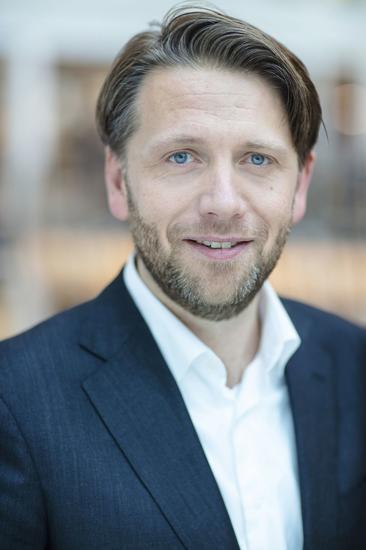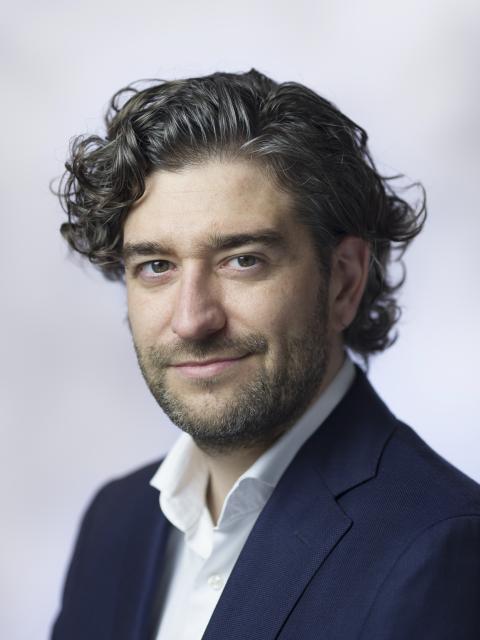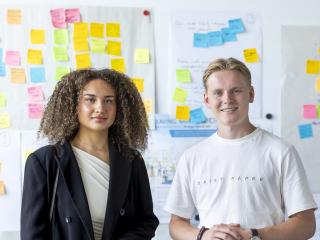Academic Collaborative Center for Climate & Energy: ‘This raises questions that we might not otherwise have asked’
A smart and socially equitable energy transition. That is the mission of the Academic Collaborative Center for Climate & Energy. This wide-ranging theme calls for a multidisciplinary approach involving a selection of civil-society partners.
While it may be fascinating, the energy transition ultimately amounts to a mammoth operation. We will need to pull out all the stops to achieve the transition to a sustainable energy supply. Sander Oosterloo is fully committed to it. This senior policy adviser at Alliander has an imposing to-do list of everything facing Dutch network operators thanks to the energy transition: “In the next two decades, we’ll need 20,000 extra engineers and by 2050 we’ll need the equivalent of 11,000 soccer pitches of space for the necessary infrastructure. Some hundred thousand kilometers of cable will need to be laid, enough to go around the world two and a half times: ultimately, one in three Dutch streets will have to be dug up.” His organization has plans to intensify, expand, and increase the flexibility of the grid. This means that they will need to build new stations and install new networks. That is no easy task in a densely-populated country. Oosterloo: “The question is: how do we find space for it? For example, if you want to implement all the spatial plans in Gelderland you’ll need a province that’s virtually twice the size.” The combination of shortage of space and long planning-permission procedures is a genuine challenge.

In this Collaborative Center, we can put the energy transition in perspective
Sander Oosterloo
Brainpower
Alliander cannot achieve the energy transition single-handedly. This is why the company is looking to collaborate with other parties. Oosterloo: “The transition involves much more than switching from one technology to another in terms of energy supply – above all it’s a social change. It will require renewal across numerous fronts: legal, administrative, in terms of spatial planning, economics, and behavior. Coming up with new insights and ideas will call on brainpower from across various different disciplines.” Indeed, this is one of the reasons why Alliander has entered into a partnership with Tilburg University’s multidisciplinary Academic Collaborative Center for Climate & Energy. Oosterloo was attracted by the idea of collaborating with scientists and other players in the energy sector, such as energy companies and government authorities. “In this Collaborative Center, we can put the energy transition in perspective. We’re joining forces in putting our minds to relevant issues and the research that will be needed.”
The collaborative center is an offshoot of a multidisciplinary community of Tilburg scientists who were already working on sustainability, climate change and energy transition
Martijn Groenleer

Collaborative agenda
The Academic Collaborative Center for Climate & Energy initially focused primarily on the energy transition, explains Public Governance Professor Martijn Groenleer. On behalf of the university, he works with Economics Professor Wendy van der Valk to ensure the smooth running of the center. Groenleer explains that there was a need for a clearly-defined theme: “We’re now focusing on a smart and socially equitable energy transition. That was the preferred choice for our scientists and partners: Alliander, Stedin, Enexis, Essent, the Province of Noord-Brabant, the City of Tilburg, the Association of (Prospective) Homeowners (VEH), the Netherlands Enterprise Agency (RVO), Avans University of Applied Sciences, Midpoint Brabant and Heijmans.” The collaborative center is an offshoot of a multidisciplinary community of Tilburg scientists who were already working on sustainability, climate change and energy transition, explains Groenleer. “Together with the partners, we’ve now determined what we want to know about the energy transition.” As part of the collaborative agenda, agreement has been reached to tackle three key themes: new energy markets & legislation and regulation, governance and citizen participation, and digitization & data in energy supply.
Achieving a sustainable energy system will require more than just the replacement of fossil fuels by renewable generation
Battery storage
Groenleer has great expectations for the collaboration between disciplines and with civil-society partners. He sees real advantages in the multidisciplinary approach. One example is battery storage, a subject that the collaborative center is exploring. Wind and solar energy are both subject to peaks and troughs in production. Ideally, one would want to store any unused energy in order to be able to use it later. Groenleer: “Universities of technologies are working on the technological solutions while we focus on the rest. Our lawyers are looking at the legal frameworks, our public administrators at forms of governance, our economists at market models and our psychologists at behavioral change.” A key advantage of collaboration is that it enables scientists to get closer to practice. Via the partners, they can gain access to data or case histories, for example about energy experiments run by partners in neighborhoods or industrial estates. The civil-society partners have an opportunity to escape the day-to-day pressure and share their questions with other players, in order to reach answers together.
Oosterloo will be joining forces with his colleagues from Alliander and working with students from Tilburg University on the theme of energy conservation: “Achieving a sustainable energy system will require more than just the replacement of fossil fuels by renewable generation. It also calls for significant energy conservation and other changes in behavior. How can we encourage energy users, such as government authorities, companies, and private individuals to do much more in that area?”
Citizens are now playing more roles than they did in the past; for example they can be both consumer and producer
Coordination
The longer you spend talking to Groenleer and Oosterloo, the more you realize how many fundamental questions the energy transition raises. One example of that is the shift from centralized to decentralized energy production. Groenleer: “Citizens are now playing more roles than they did in the past; for example they can be both consumer and producer. This means they can play a role in democratizing the energy system. This transition is a unique opportunity to strengthen the role and responsibility of local communities.”
Another fundamental question is how all of this can be run smoothly in a densely-populated country: who will take charge of coordination? Oosterloo would very much like to work toward a targeted energy-planning system. “That will enable us to make system-efficient spatial design choices and develop transition pathways focusing on the optimum use of energy carriers and solutions within the energy system. Currently, the energy transition is still happening too much from the bottom-up, with choices based primarily on self-optimization.” Oosterloo hopes that the Collaborative Center will help to achieve solutions: “Whatever happens, this collaboration will help us to include knowledge from numerous perspectives and hopefully it will lead us toward shared visions of the future.”
Groenleer: “For us, this collaboration is raising urgent and important questions that we might not otherwise have asked. Let’s hope that we can achieve answers together that can benefit society, in the short-, but perhaps more importantly, in the longer term.”
Academic collaborative centers
Tilburg University’s Wellbeing program uses the academic collaborative centers as its main instrument. Four of these have now been established.
Governance and Management for Wellbeing
This center focuses on monitoring and measuring the impact of policy on wellbeing. How can public and private organizations achieve better wellbeing and broader prosperity?
Partners: City of Tilburg, Midpoint Brabant, Province of Noord-Brabant, PON-Telos, VBG, Municipality of Waalwijk
Digital health & Mental Wellbeing
This center looks for ways to improve mental wellbeing using digital tools and resources. Its mission is: ‘To make working on your mental health the most normal thing in the world by the year 2030.’
Partners: Zorg van de Zaak, GGZ Breburg, GGZ Eindhoven, City of Tilburg, Elisabeth-Tweesteden Hospital and Antoni van Leeuwenhoek Hospital.
Climate & Energy
This center aims to help develop expertise to enable the transition to a more sustainable way of living and working. One important challenge is: how can we achieve an energy transition that is socially equitable?
Partners: Alliander, Essent, Vereniging Eigen Huis, City of Tilburg, Province of Noord-Brabant, Stedin, Netherlands Enterprise Agency, Heijmans, Midpoint Brabant, Enexis, Avans, Pon-Telos.
Inclusive Labor Market
This center focuses on uncertainty around work and income, and examines how we can address that uncertainty. The participants are seeking new infrastructure for the labor market by 2030, so that everybody is able to work and move from job to job.
Partners: Total Care (CSU), ING, NS, KLM, UWV, Randstad, Rabobank, CNV, Philips and Achmea.
For more information about the Wellbeing program and the centers:
Date of publication: 21 September 2023



